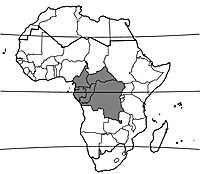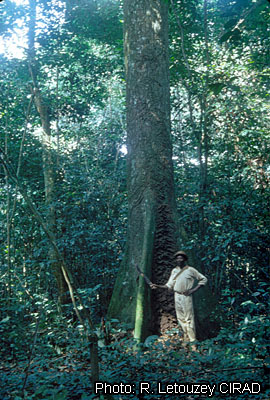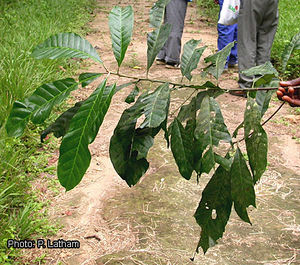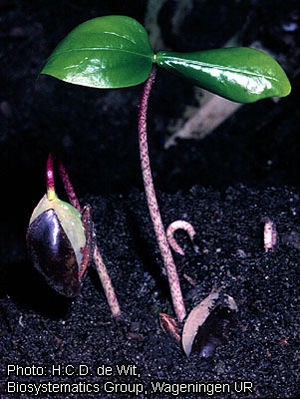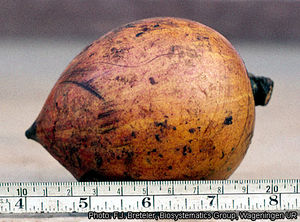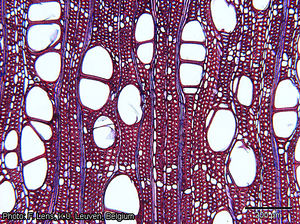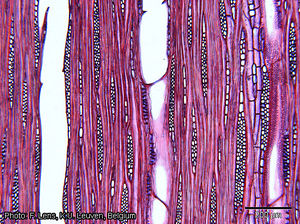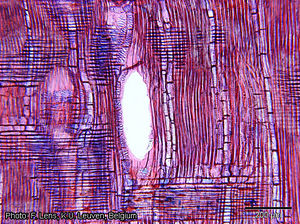Chrysophyllum lacourtianum (PROTA)
Introduction |
Chrysophyllum lacourtianum De Wild.
- Protologue: Miss. Ém. Laurent 1: 425 (1907).
- Family: Sapotaceae
- Chromosome number: 2n = 28
Synonyms
- Chrysophyllum autranianum A.Chev. (1917),
- Gambeya lacourtiana (De Wild.) Aubrév. & Pellegr. (1960).
Vernacular names
- Abam, longhi, longhi rouge (Fr).
Origin and geographic distribution
Chrysophyllum lacourtianum occurs from Cameroon to the Central African Republic, Gabon and DR Congo.
Uses
The wood (trade names: abam, longhi) is suitable for construction, light flooring, interior trim, mine props, railway sleepers, ships, vehicle bodies, furniture, cabinet work, implements, sporting goods, carvings, turnery, veneer, plywood, hardboard, particle board and pulp for paper production.
The sweet acidulous pulp of very ripe fruits is commonly eaten fresh. In Gabon the Bakota and Bakwélé people eat the salted pulp with staple foods such as cassava and plantain. Dried pulp is occasionally used in sauces. In Congo a bark decoction is applied vaginally to treat inflammations of uterus and vagina, and it is used in vapour baths to treat rheumatism and kidney pain. Bark powder is applied to wounds. In DR Congo a maceration of the root bark is applied topically to treat earache.
Production and international trade
The timber of Chrysophyllum lacourtianum is traded internationally in small volumes, but data are not available due to mixing with other Sapotaceae species. The fruits are commonly found on local markets in Central Africa.
Properties
The heartwood is yellowish white to yellow-brown, sometimes with ribbon-like or mottled figure, and indistinctly demarcated from the sapwood, which is up to 5 cm wide. The grain is usually straight, texture fine to moderately fine.
The wood is medium-weight, with a density of 685–730 kg/m³ at 12% moisture content. With some care, the wood air dries well with little degrade, but it should be quartersawn and dried slowly.
At 12% moisture content, the modulus of rupture is 133–150 N/mm², modulus of elasticity 15,790 N/mm², compression parallel to grain 55–70 N/mm², cleavage 15.7–20.6 N/mm and Chalais-Meudon hardness 3.6–4.2. The wood is brittle and not very shock-resistant.
The wood is fairly easy to saw, works well with hand and machine tools, and it can be planed to a smooth finish. It does not easily split on nailing, and it holds nails and screws well. The wood is only moderately durable and liable to attacks by blue stain, termites and marine borers. The sapwood is fairly permeable to preservatives, the heartwood resistant.
The fresh fruit contains per 100 g: water 71 g, energy 376 kJ (90 kcal), protein 1,4 g, fat 6,6 g, carbohydrate 6,2 g, Ca 17 mg, P 14 mg.
Description
- Large tree up to 40 m tall; bole branchless for up to 24 m, straight and cylindrical, sometimes fluted, up to 100 cm in diameter, with steep buttresses at base; bark up to 2.5 cm thick, surface greyish brown, fissured, inner bark fibrous, brown, exuding a sticky latex; crown spreading; young branches greyish hairy.
- Leaves arranged spirally in tufts at the ends of branches, simple and entire; stipules absent; petiole 2–3 cm long, grooved above; blade elliptical to obovate-oblong, 11–36 cm × 4.5–12.5 cm, cuneate at base, shortly acuminate at apex, glabrous, pinnately veined with 10–17 pairs of lateral veins.
- Flowers in axillary fascicles, bisexual, regular, 5-merous; pedicel c. 3 mm long; sepals free, broadly ovate, c. 4 mm long, pubescent outside; corolla with c. 2.5 mm long tube and rounded lobes c. 1 mm long, hairy at margins, creamy white; stamens inserted near base of corolla tube, opposite corolla lobes; ovary superior, conical, long-hairy, 5-celled, style short.
- Fruit a large, ovoid to globose berry 6–11 cm long, becoming orange to red and glabrous when ripe, up to 5-seeded.
- Seeds ellipsoid, flattened, up to 3.5 cm × 2 cm, shiny brown.
- Seedling with epigeal germination.
Other botanical information
Chrysophyllum comprises about 70 species and occurs throughout the tropics. Tropical America is richest in species (about 45), followed by continental Africa (about 15), Madagascar (about 10) and tropical Asia and Australia (together 2). The genus has been subdivided into 6 sections, 2 of which (sect. Aneuchrysophyllum and sect. Donella) contain African species. Chrysophyllum lacourtianum belongs to sect. Aneuchrysophyllum.
Anatomy
Wood-anatomical description (IAWA hardwood codes):
- Growth rings: 2: growth ring boundaries indistinct or absent.
- Vessels: 5: wood diffuse-porous; 13: simple perforation plates; 22: intervessel pits alternate; (25: intervessel pits small (4–7 μm)); 26: intervessel pits medium (7–10 μm); 30: vessel-ray pits with distinct borders; similar to intervessel pits in size and shape throughout the ray cell; (31: vessel-ray pits with much reduced borders to apparently simple: pits rounded or angular); 32: vessel-ray pits with much reduced borders to apparently simple: pits horizontal (scalariform, gash-like) to vertical (palisade); (33: vessel-ray pits of two distinct sizes or types in the same ray cell); 42: mean tangential diameter of vessel lumina 100–200 μm; 46: ≤ 5 vessels per square millimetre; 56: tyloses common.
- Tracheids and fibres: 61: fibres with simple to minutely bordered pits; 66: non-septate fibres present; 69: fibres thin- to thick-walled.
- Axial parenchyma: 86: axial parenchyma in narrow bands or lines up to three cells wide; (87: axial parenchyma reticulate); (88: axial parenchyma scalariform); 93: eight (5–8) cells per parenchyma strand.
- Rays: (97: ray width 1–3 cells); 98: larger rays commonly 4- to 10-seriate; 107: body ray cells procumbent with mostly 2–4 rows of upright and/or square marginal cells; 108: body ray cells procumbent with over 4 rows of upright and/or square marginal cells; 115: 4–12 rays per mm.
- Mineral inclusions: 136: prismatic crystals present; 138: prismatic crystals in procumbent ray cells; 142: prismatic crystals in chambered axial parenchyma cells.
Growth and development
Growth of Chrysophyllum lacourtianum seedlings is slow, 6–10 cm/year during the first three years. In Gabon Chrysophyllum lacourtianum flowers in July–August, during the dry season. In this period the trees are often leafless for a short period. They fruit regularly, often every year but sometimes once every two years, and fruits take about 12 months to ripen. In Gabon ripe fruits are found in May–September. The seeds are dispersed by primates (including gorillas and chimpanzees) and elephants. Germinating seedlings have been observed in elephant dung. Seedlings around mother trees are rare. This has been attributed to intensive predation of the fruits by rodents and wild pigs, which destroy the seeds.
Ecology
Chrysophyllum lacourtianum occurs particularly in dense semi-deciduous forest, where it often occurs scattered and is generally uncommon. In DR Congo it is locally common together with Celtis spp. on sandy-loamy soils in gallery forest in valleys, where the average annual rainfall is 1400–1500 mm and the mean annual temperature 24°C.
Propagation and planting
Seeds start germinating after 50 days and germination may take over 100 days. Seedlings need shade.
Management
Chrysophyllum lacourtianum is rarely planted, but trees are commonly maintained when clearing the forest for agriculture.
Harvesting
The fruits are collected from the ground.
Handling after harvest
Logs should not be left in the forest for too long after felling because they are liable to blue stain; they should be converted as soon as possible.
Genetic resources
Although Chrysophyllum lacourtianum is relatively uncommon in many regions within its distribution area, it is not immediately liable to genetic erosion because it is quite widespread in regions where forest is still common.
Prospects
In spite of the fact that Chrysophyllum lacourtianum is an interesting timber and fruit tree, very little research has been done on its propagation and possibilities of domestication. However, its apparently slow growth is a serious drawback.
Major references
- Bolza, E. & Keating, W.G., 1972. African timbers: the properties, uses and characteristics of 700 species. Division of Building Research, CSIRO, Melbourne, Australia. 710 pp.
- Bourobou-Bourobou, H., 1994. Biologie et domestication de quelques arbres fruitiers de la forêt du Gabon. Thèse Université Montpellier II - Sciences et Techniques du Languedoc, Montpellier, France. 340 pp.
- Latham, P., 2004. Useful plants of Bas-Congo province, Democratic Republic of the Congo. DFID, London, United Kingdom. 320 pp.
- Takahashi, A., 1978. Compilation of data on the mechanical properties of foreign woods (part 3) Africa. Shimane University, Matsue, Japan, 248 pp.
- Wilks, C. & Issembé, Y., 2000. Les arbres de la Guinée Equatoriale: Guide pratique d’identification: région continentale. Projet CUREF, Bata, Guinée Equatoriale. 546 pp.
Other references
- Aubréville, A., 1961. Sapotacées. Flore du Gabon. Volume 1. Muséum National d’Histoire Naturelle, Paris, France. 162 pp.
- Aubréville, A., 1964. Sapotacées. Flore du Cameroun. Volume 2. Muséum National d’Histoire Naturelle, Paris, France. 143 pp.
- CTFT (Centre Technique Forestier Tropical), 1961. Résultats des observations et des essais effectués par le CTFT sur abam, Chrysophyllum lacourtianum de Wild. (Sapotacées). Information technique No 97. Centre Technique Forestier Tropical, Nogent-sur-Marne, France. 3 pp.
- Glouchkoff, A.R.P., undated. Toute la diététique, table de composition des aliments. [Internet] http://www.i-dietetique.com/?action=aliment. October 2006.
- InsideWood, undated. [Internet] http://insidewood.lib.ncsu.edu/search/. May 2007.
- Lubini, A. & Kusehuluka, K., 1991. La forêt ombrophile semi-sempervirente à Celtis mildbraedii et Gambeya lacourtiana dans la region de Kikwit (Zaïre). Bulletin du Jardin botanique national de Belgique 61: 305–334.
- Neuwinger, H.D., 2000. African traditional medicine: a dictionary of plant use and applications. Medpharm Scientific, Stuttgart, Germany. 589 pp.
- Obama Ondo, C., 2002. Estudio de productos forestales no maderables en tres mercados de Guinea Ecuatorial. Anales del Jardín Botánico de Madrid 59(2): 275–285.
- Raponda-Walker, A. & Sillans, R., 1961. Les plantes utiles du Gabon. Paul Lechevalier, Paris, France. 614 pp.
Sources of illustration
- de Wildeman, E., 1905–1907. Mission Emile Laurent: 1903–1904. 2 volumes. Vanbruggenhoudt, Brussels, Belgium.
- Wilks, C. & Issembé, Y., 2000. Les arbres de la Guinée Equatoriale: Guide pratique d’identification: région continentale. Projet CUREF, Bata, Guinée Equatoriale. 546 pp.
Author(s)
- R.H.M.J. Lemmens, PROTA Network Office Europe, Wageningen University, P.O. Box 341, 6700 AH Wageningen, Netherlands
Correct citation of this article
Lemmens, R.H.M.J., 2007. Chrysophyllum lacourtianum De Wild. In: Louppe, D., Oteng-Amoako, A.A. & Brink, M. (Editors). PROTA (Plant Resources of Tropical Africa / Ressources végétales de l’Afrique tropicale), Wageningen, Netherlands. Accessed 31 March 2025.
- See the Prota4U database.

